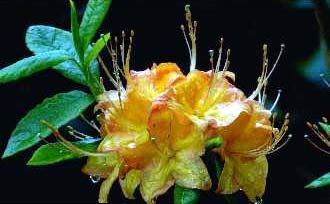No plant is safe from insect attacks. Spotting a few bugs on your roses does not indicate an infestation. The important concept of pest control is to control damage, not to necessarily eliminate all the bugs.
A healthy rose is more resistant to attacks by insects than a weak rose. A regular schedule of fertilizing and watering your roses will do more to protect them from insects than any chemical insecticide. Since many insects are spread by contact, keeping your rose garden clean will help to prevent problems. After pruning in spring, clean up leaves and any debris on the ground beneath the bushes. Destroy any trimmings that show evidence of insect damage or disease - do not add them to your compost.
Pay regular attention to your roses. If you wait until the plant is covered with insects, it may be too late. Washing the foliage with a strong spray of water as soon as insects appear is often enough to control many pests.
Natural Control of Aphids
Rose aphids have protective green coloring that makes them hard to notice on your plants. They settle on new shoots, the undersides of leaves, on stems, and on the base of buds where they suck the juices from the plant. This causes puckered leaves and malformed flowers. Aphids also transmit fungus and bacterial diseases. They secrete honeydew, a sticky substance that attracts ants, which in turn carry the aphids to new plants.
If only a few roses affected, you can destroy the aphids by simply rubbing the leaves which carry the aphids. Aphid population can be curbed with natural controls such as ladybugs and lacewings, both of which are available commercially. Planting garlic, nasturtiums, anise, chives, or lavender between your roses will help keep aphids away. Spraying with soap and water, tobacco tea, or even a strong blast of plain water will also remove aphids.
Scale
Scale is most frequently found on neglected bushes. There are several varieties that attack roses. They resemble small oysters, about 1/4 inch long, and range in color from gray to brown to black. They feed on the sap of leaves and stems causing the plant to wilt and sometimes die. On small areas, scale can be scraped off or brushed with soapy water or turpentine. Cut down to the ground and destroy any infested canes. Dormant-oil spray, a nontoxic spray made by suspending oil in an emulsion, can be used to suffocate these pests.
Leafhoppers
Leafhoppers are wedge-shaped, sucking insects that carry many viruses. They can hop great distances when disturbed. They feed by puncturing the foliage, creating a white stippled effect and curling the edges of the leaves. Pyrethrum is often effective against leafhoppers. Also, keeping weeds under control can prevent the problem.
Spider Mites
Spider mites are tiny, 8-legged creatures that resemble spiders. They thrive in hot, humid weather and in areas with poor air circulation. They feed on the cell sap from the surface tissue of the leaves causing them to turn red, yellow, gray, or brown. Hose off plants to wash away the mites and break down the webs. Repeat this at least 3 days in succession to disrupt the breeding and hatching cycle of the mites.
Rose Curculios
Rose curculios are hard-shelled beetles, � inch long with protruding curved snouts. They drill through the buds, making holes in the unopened petals. Control rose curculios by hand-picking them off the plant. Cut off the ruined buds before the larvae have a chance to mature.
Caterpillars
There are two varieties of caterpillars that damage roses: the budworm, which is green or pale orange, measuring 3/8 inch in length; and the rose-leaf tier, which is pale green and 3/4 inch long. These pests eat both the rosebuds and the leaves. Pick off and destroy infested buds and leaves.
Thrips
Thrips are tiny, sucking insects with slender orange-yellow or brown-yellow bodies and two pairs of long, fringed wings. Flowers are the chief target of a thrip attack; light-colored roses show the damage most. Thrips suck out the juice scarring the flowers and preventing them from opening. Weed control is the most important means of preventing a thrip attack. Remove any infested blooms and buds. Sprays of oil and water or an application of rotenone are effective if the problem is detected early.
Rose Gallwasp
Rose gallwasps are 4-winged, tiny wasps that lay their eggs on stems forming an abnormal growth, called a gall. One variety, mossy rose gall, looks like a fibrous mass of green and purple filaments on the stem. Another variety, rose root gall, swells into a ball measuring 1 to 2 inches in diameter at the base of the plant or just below the soil. Cut off and destroy infested galls as you find them.
TIPS: BOTANICAL REPELLENTS
1)
Botanical sprays are derived from plant species and are nonpersistent in the environment. Pyrethrum is made from chrysanthemums. The pulverized flowers are toxic to insects, especially aphids, whiteflies, leafhoppers, and thrips.
2)
Pesticides and herbicides not used according to label directions can be harmful to humans, animals, and plants. Only use products that have directions for home and garden use.
SOME INTERESTING FACTS: KNOW YOUR ENEMY
1)
The eggs of aphids overwinter in tree bark and on perennial plants
2)
Ladybugs and their larvae are important predators of aphids. One can eat about 400 aphids.
3)
Stinging nettle tea is one remedy for aphids.
4)
Planting lavender among your roses helps keep ants away.
5)
Rose leafhoppers suck on the underside of the leaf.
6)
White stippling on the upper leaf surface is a sign of leafhoppers.
7)
Crinkled leaves can also signal their presence.


